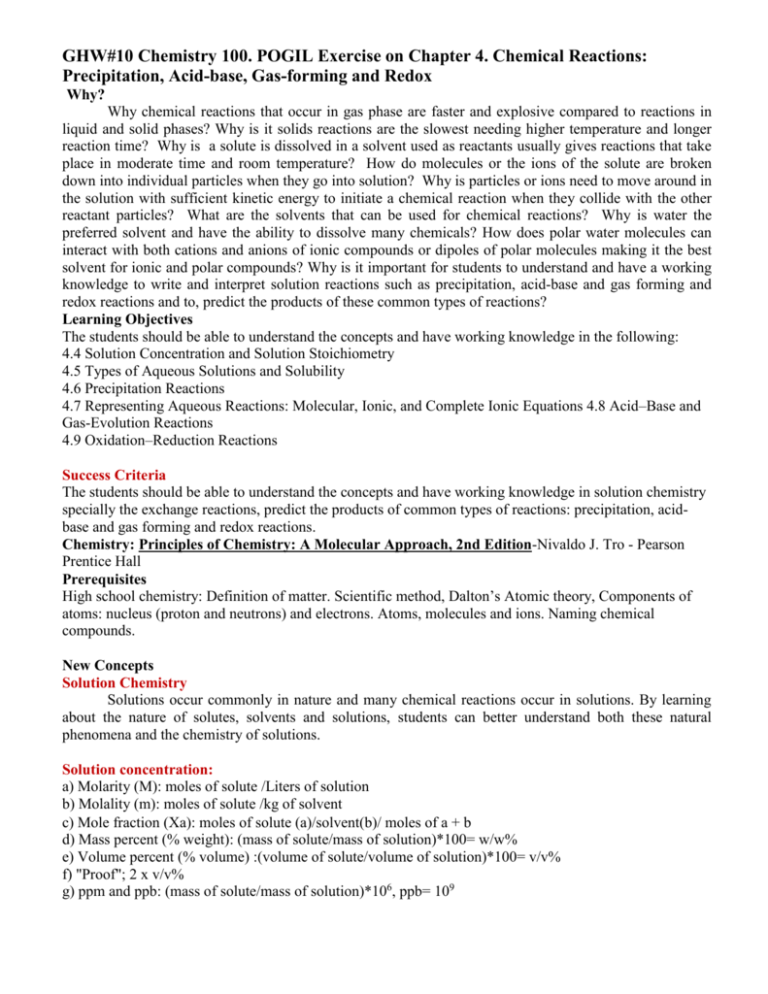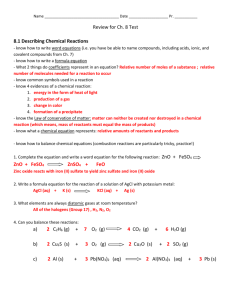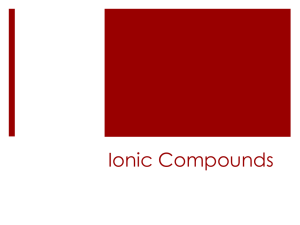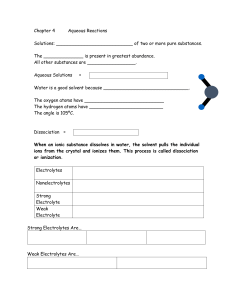
GHW#10 Chemistry 100. POGIL Exercise on Chapter 4. Chemical Reactions:
Precipitation, Acid-base, Gas-forming and Redox
Why?
Why chemical reactions that occur in gas phase are faster and explosive compared to reactions in
liquid and solid phases? Why is it solids reactions are the slowest needing higher temperature and longer
reaction time? Why is a solute is dissolved in a solvent used as reactants usually gives reactions that take
place in moderate time and room temperature? How do molecules or the ions of the solute are broken
down into individual particles when they go into solution? Why is particles or ions need to move around in
the solution with sufficient kinetic energy to initiate a chemical reaction when they collide with the other
reactant particles? What are the solvents that can be used for chemical reactions? Why is water the
preferred solvent and have the ability to dissolve many chemicals? How does polar water molecules can
interact with both cations and anions of ionic compounds or dipoles of polar molecules making it the best
solvent for ionic and polar compounds? Why is it important for students to understand and have a working
knowledge to write and interpret solution reactions such as precipitation, acid-base and gas forming and
redox reactions and to, predict the products of these common types of reactions?
Learning Objectives
The students should be able to understand the concepts and have working knowledge in the following:
4.4 Solution Concentration and Solution Stoichiometry
4.5 Types of Aqueous Solutions and Solubility
4.6 Precipitation Reactions
4.7 Representing Aqueous Reactions: Molecular, Ionic, and Complete Ionic Equations 4.8 Acid–Base and
Gas-Evolution Reactions
4.9 Oxidation–Reduction Reactions
Success Criteria
The students should be able to understand the concepts and have working knowledge in solution chemistry
specially the exchange reactions, predict the products of common types of reactions: precipitation, acidbase and gas forming and redox reactions.
Chemistry: Principles of Chemistry: A Molecular Approach, 2nd Edition-Nivaldo J. Tro - Pearson
Prentice Hall
Prerequisites
High school chemistry: Definition of matter. Scientific method, Dalton’s Atomic theory, Components of
atoms: nucleus (proton and neutrons) and electrons. Atoms, molecules and ions. Naming chemical
compounds.
New Concepts
Solution Chemistry
Solutions occur commonly in nature and many chemical reactions occur in solutions. By learning
about the nature of solutes, solvents and solutions, students can better understand both these natural
phenomena and the chemistry of solutions.
Solution concentration:
a) Molarity (M): moles of solute /Liters of solution
b) Molality (m): moles of solute /kg of solvent
c) Mole fraction (a): moles of solute (a)/solvent(b)/ moles of a + b
d) Mass percent (% weight): (mass of solute/mass of solution)*100= w/w%
e) Volume percent (% volume) :(volume of solute/volume of solution)*100= v/v%
f) "Proof"; 2 x v/v%
g) ppm and ppb: (mass of solute/mass of solution)*106, ppb= 109
Classification of compounds as molecular compounds, acids, bases and salts
Molecular compounds that don’t affect the hydrogen (H+) or hydroxide (OH-) ion concentrations when
dissolved in water.
Acids: Acids are compounds that increase the hydrogen (H+) hydrogen ion concentration when dissolved in
water. This involves dissociation of a molecular compound in water.
Base: Bases are compounds that increase the hydroxide (OH-) hydrogen ion concentration when dissolved
in water. This involves dissociation of hydroxides or a molecular compound in water.
Salts: Salts are formed when an acid reacts with a base. Salts normally don't have acidic protons or OH ions. E.g. HCl(acid) + NaOH(base) --> NaCl (salt) + H2O.
Molecular
compounds
C6 H12 O6(aq)
CH3CH2OH(aq)
C12 H22 O11(aq)
C6H14(l)
A.
B.
C.
1.
2.
1.
2.
3.
4.
Acid and salts
Acid
HC2H3O2
HCl
HNO3
H3PO4
H2SO4
Sodium(+ NaOH(aq)) salt
NaC2H3O2
NaNO3
Na3PO4
Na2SO4
Na2SO4
Base and salts
Base
NaOH(aq)
BaO (aq)
CaO (aq)
Mg(OH)2(s)
NH3(g)
Chloride Salt (+ HCl(aq))
NaCl (aq)
BaCl2(aq)
CaCl2(aq)
MgCl2(aq)
NH4Cl(s)
Solubility of molecular compounds
Neutral molecular compounds: depends on the rule “ like dissolves like” polar compounds dissolves in
water and non-polar compounds are insoluble.
Dissociating acids in water (E.g. HCl(aq) + H2O(l)= H3O+(aq) + Cl-(aq))
E.g. HCl (aq), HBr(aq), HI(aq), H2SO4(aq), HNO3(aq), HClO4(aq)
Partially-dissociating acids in water all acids except in B above.
E.g. CH3COOH(aq) + H2O(l)
H3O+(aq) + CH3COOH-(aq))
(E.g. CH3COOH(aq), HF(aq), HCN(aq), H3PO4(aq), HCOOH(aq), H2CO3(aq))
Solubility of ionic compounds
A. Soluble compounds in water
All salts of alkali metal (group 1) ions and the NH4+ ion (E.g. NaCl(aq), Li2CO3(aq), CsBr(aq),
NH4NO3(aq))
All salts of NO3-, CH3CO2-, ClO3-, ClO4- ions (E.g. Ca(NO3)2(aq), CH3CO2Na(aq), Ba(ClO3)2(aq),
Fe(ClO4)2(aq)
B. Insoluble compounds
Cl-, Br-, and I- ions salts of Ag+, Pb+2, and Hg2+2 (E.g. AgCl (s), PbBr2 (s), and Hg2I2 (s)
SO42- ion salts of Ca+2, Ba+2, and Pb+2 (E.g. CaSO4 (s), BaSO4 (s), and PbSO4 (s)
OH- ions and metals (E.g. Al(OH)3 (s), Cu(OH)2(s), Mg(OH)2(s)
Except Group 1. (E.g. NaOH (aq), Li3PO4(aq), CsOH(aq) )
Except Group 2. Ca(OH)2 (aq) Sr(OH)2 (aq), Ba(OH)2 (aq)
CO3-2, PO4-3, O-2, and S-2 ion salts CaCO3(s), Mg3(PO4)2(s), MnO2(s), CuS(s) Except rule A 1. (E.g.
Na2CO3(aq), Li3PO4(aq), CsOBr(aq), (NH4)2S(aq)
Types of chemical equations written for solution reactions
Molecular equation. Equation with formula, correct stoichiometric coefficients and physical form written
within parenthesis.
NaCl(aq) + AgNO3(aq) ----> AgCl(s) + NaNO3(aq)
Total ionic equation: All the ionic compounds soluble in water are separated into ions written with their
ionic charge and (aq).
Na+ (aq) + Cl- (aq) + Ag+ (aq) + NO3- (aq) --> AgCl (s) + Na+ (aq) + NO3- (aq)
Spectator Ions: Ions appearing on both side of an ionic equation.
Na+ (aq) + Cl- (aq) + Ag+ (aq) + NO3- (aq) --> AgCl (s) + Na+ (aq) + NO3- (aq)
Spectator Ions: Na+ (aq) and
NO-3 (aq)
Net Ionic equation: Ionic equation with all spectator ions removed from both sides.
Na+ (aq) + Cl- (aq) + Ag+ (aq) + NO3- (aq) --> AgCl (s) + Na+ (aq) + NO3- (aq)
Cl- (aq) + Ag+ (aq) --> AgCl (s)
Common types of solution reactions
Exchange of double displacement reactions
a) Precipitation reactions: A precipitation reaction is a reaction in which soluble ions in separate solutions are mixed
together to form an insoluble compound that settles out of solution as a solid. That insoluble compound is called a precipitate.
Salt solution 1
Salt solution 2
Insoluble salt
Soluble salt 3
= BaSO4 (s) +
E.g. Ba(NO3)2 (aq) +
Na2SO4 (aq)
2 NaNO3(aq)
b) Acid/Base reactions
Acid
Base
H2SO4 (aq) +
Ca(OH)2 (aq)
c) Gas forming reactions
Acid
Salt
2HCl(aq)+
Na2S (aq)
=
=
Salt
water
2 CaSO4 (s) +
2 H2O (l)
gas
salt
H2S(g)
2NaCl(aq)
Oxidation-Reduction Reactions
Redox reactions primarily involve the transfer of electrons between two chemical species.
All single replacement reaction are redox reactions.
Single Displacement: AX + Y
YX + A: The reaction follows Activity series:
Metals: Li> K>Ca>Na>Mg>Al>Zn>Cr>Fe>Ni>Sn>Pb>H>Cu>Hg>Ag>Pt>Au
E.g. Fe + Cu(NO3)2
Fe(NO3)2 + Cu,
Non-metals: F>Cl>Br>I
E.g. Cl2 + 2 NaI
2 NaCl + I2
LEO The Lion Goes GER!
Oxidation: The compound have an atom that loses an electron is said to be oxidized
Reduction: The compound have an atom that gains an electron is said to be reduced.
Oxidation number: number of lost or gained relative to neutral atom.
Reducing agent: the reactant that gives up electrons and increases oxidation number.
Oxidizing agent: the reactant that gains electrons and increases oxidation number..
Oxidation number: number of lost or gained relative to neutral atom
Assign Oxidation Numbers to atoms in a compound or ion.
A. Elements: Oxidation number (ON) of atoms in an element is zero (0). E.g. O2
B. Monoatomic ions: ON equal to charge. E.g. Na+, ON = +1; Cl-, ON = -1
C. The group number in the periodic table: could be used for main group elements. Transition metals
show variable ONs E.g. Fe shows either +3 or +2.
D. Sum of the oxidation numbers: In an element, compound is equal to zero.
E. Sum of the oxidation numbers: In an a cation/ anion is equal to the ionic charge.
F. Almost most of the time: ON of H =+1, and O=-2
E.g. What is the oxidation number or state of Cl in HClO4?
H +1, O -2 neutral compound, thus sum is equal to zero
4O 4 -2 = -8; H 1 +1 = +1; 0 = +1(H) + y(Cl) + (-8)
y = +7
Oxidation number or state of Cl in HClO4 is +7.
E.g. What are the oxidation numbers, reducing agent, oxidizing agent, reduction half reaction
(RHR) and oxidation half reaction (OHR) for the following reaction?
Reaction:
Zn (s) +
2 HCl (aq)
ZnCl2 (aq) + H2 (g)
Oxidation number
Zn= 0
H = +1 Cl= -1
Zn= +2, Cl= -1 H=0
Reducing agent :
Zn (s)
Oxidizing agent: HCl (aq)
+
Reduction Half Reaction (RHR)
2H (aq) + 2e -
H2 (g)
Oxidation Half Reaction (OHR)
Zn (s)
Zn2+ (aq) + 2e -
GHW#10 Name:________________________ Date submitted:_________Group:_____ _
Key Questions (relatively simple to answer using the Focus Information)
1) Identify the gas phase, solution (liquid) and solid phase reactions.
a) O2(g) + 2 H2(g)
2 H2O(l):
b) AgNO3(aq) + NaCl(aq)
c) 2C4H10(g) + 13O2(g)
AgCl(s) insoluble salt + NaNO3(aq)
8CO2(g) + 10H2O(g):
d) 2 Al (s) + Fe2O3 (s) = 2 Fe(s) + Al2O3(s):
2) Molarity Calculations: Calculate the molarity of a solution prepared by dissolving 200.0 g of K2SO4 in
enough water to make 500.0 mL solution.
3) Gram-mol-M conversions: How many grams of KNO3 are contained in 500 mL of a 0.500 M solution of
potassium nitrate?
4) Dilution problems: How many mL of 2.00 M solution of nitric acid, HNO3 are required with water to
make a 250 mL of 1.50 M HNO3 acid solution?
5) What is concentration of Cl- in 0.4 M MgCl2 aqueous solution if MgCl2 a strong electrolyte?
6) Classify following solution reactions as precipitation, acid/base and redox reactions.
a) KOH (aq)
+ HNO3(aq) -->
KNO3(aq) + H2O(l):
b) HCl(aq) + NaHCO3(aq) -->NaCl(aq) + H2O(l) + CO2(g):
c) Fe(s) + Cu(NO3)2(aq) --> Fe(NO3)2(aq) + Cu(s)
d) AgNO3(aq) + NaCl(aq) --> AgCl(s) + NaNO3(aq)
e) NaOH(aq) + HC2H3O2(aq)
--> NaC2H3O2(aq) + H2O(l)
7) Identify molecular compounds, acids, bases, and salts among the following:
a) AgNO3 b) NaCl
g) NaNO3
l) KNO3
c) C6H12O6 d) H3PO4
h ) CH3OH
m) HNO3
e) NaOH
f) HCl,
i) CH3COOH j) H2SO4 k) HC2H3O2
n) MgO
o) K2O
p) SO3
8) Identify the precursor acid and base for the following salts:
a) AgNO3 b) NaCl
c) NaNO3
d) K2SO4,
e) NaC2H3O2
9) Write molecular, total ionic, and net ionic reactions for the following solution reactions
a) Ba(NO3)2 (aq) + Na2SO4 (aq)
----> BaSO4 (s) + 2NaNO3 (aq)
i) Molecular equation:
ii) Total ionic equation:
iii) Spectator Ions:
iv) Net ionic equation:
b) HCl(aq) + NaOH(aq)
i) Molecular equation:
ii) Total ionic equation:
iii) Spectator Ions:
iv) Net ionic equation:
----> NaCl(aq) + H2O(l)
c) NaOH(aq) + HC2H3O2(l)
i) Molecular equation:
ii) Total ionic equation:
iii) Spectator Ions:
iv) Net ionic equation:
----> NaC2H3O2(aq) + H2O(l)
10) Which of the following salts (ionic compounds) is soluble/insoluble in water?
a) NaCl
b) Li2CO3
c) AgCl
d) PbBr2 e) NH4NO3 f) Ca(NO3)2
g) CaSO4
h) CaCO3
m) CH3CO2Na n) Cu(OH)2
i) Mg3(PO4)2 j) MnO2
k) Al(OH)3
l) BaSO4
o) Fe(ClO4)2
11) Assign the oxidation number or states to each atom in following chemicals
a) NaCl
b) O2
c) CBr4
d) S8
e)
MnO2
f) K2Cr2O7
Na=
O=
C=
S=
Mn =
K=
Cl =
Br =
O=
O=
Cr =
12) Identify the reducing and oxidizing agent (reactants) in the following reactions
a)
Reaction:
Oxidation number
Reducing agent:
Cu(s) + AgNO3(aq)
Cu =
Ag = N= O =
---> Ag(s) + Cu(NO3)2(aq)
Ag =
Cu= N= O=
Oxidizing agent:
b)
Reaction:
Oxidation number
Reducing agent:
Fe(s) + Cu(NO3)2(aq )
Fe =
Cu = N= O =
Oxidizing agent:
---> Fe(NO3)2(aq) + Cu(s)
Fe = N= O= Cu =
c)
Reaction:
Oxidation number
Reducing agent:
Ca(s)
Ca =
+ H2O(l) --->
H= O=
Ca(OH)2(aq)
+ H2(g)
Cu = O= H =
H2 =
Oxidizing agent
Reduction Half Reaction (RHR)
Oxidation Half Reaction (OHR)
13) How many mLs of 0.100 M BaCl2 are required to react completely with 25 mL of 0.200 M Fe2(SO4)3?
3 BaCl2(aq) + Fe2(SO4)3(aq)---> 3 BaSO4(s) + 2 Fe Cl3(aq)







